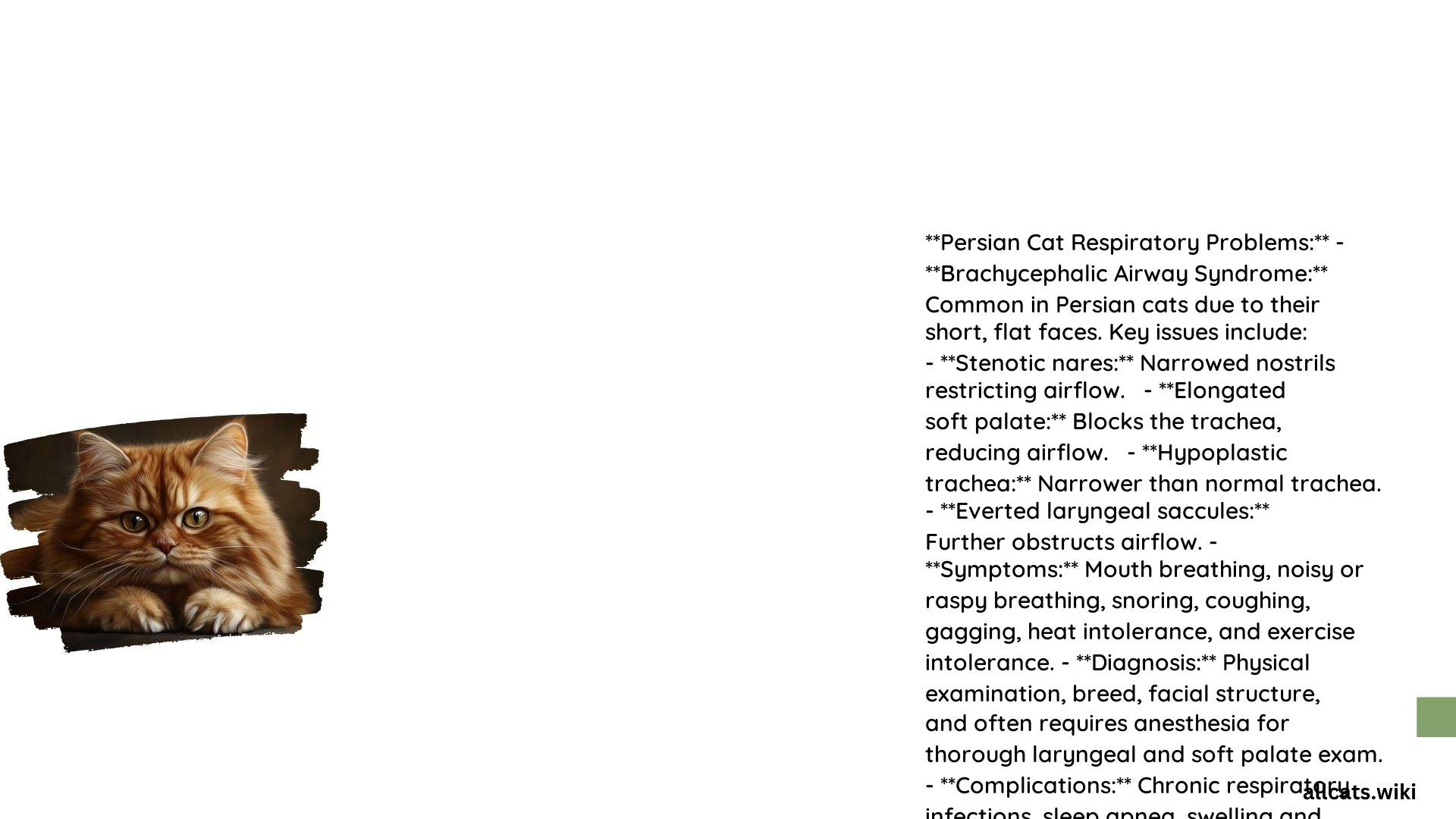Persian cats are prone to various respiratory issues due to their brachycephalic (short-nosed) facial structure. These respiratory problems can significantly impact the cat’s quality of life and require prompt veterinary attention. In this comprehensive guide, we will explore the common respiratory problems in Persian cats, their anatomical implications, symptoms, and necessary medical interventions.
What is Brachycephalic Airway Syndrome (BAOS) in Persian Cats?

Brachycephalic Airway Syndrome (BAOS) is a condition that affects Persian cats and other brachycephalic breeds. This syndrome is characterized by several anatomical abnormalities that restrict airflow and cause respiratory distress.
What are the Anatomical Implications of BAOS in Persian Cats?
- Stenotic Nares: Persian cats often have abnormally narrow nostrils, which restrict airflow into the nose.
- Elongated Soft Palate: The soft palate is too long for the mouth, partially blocking the entrance to the trachea.
- Hypoplastic Trachea: Some Persian cats have a narrower than normal trachea, further restricting airflow.
- Everted Laryngeal Saccules: These small pouches near the larynx can evert and obstruct the airway due to increased respiratory effort.
What are the Prevalence Rates of BAOS in Persian Cats?
While specific prevalence rates for BAOS in Persian cats are not widely documented, it is a common issue in brachycephalic breeds. Studies suggest that a significant portion of brachycephalic cats will develop some form of respiratory distress.
What are the Symptoms of Breathing Difficulties in Persian Cats?

Persian cats with respiratory problems may exhibit the following symptoms:
- Open-Mouth Breathing: Cats may breathe through their mouths instead of their noses.
- Increased Breathing Effort: Noisy or labored breathing, especially during exercise or in hot weather.
- Snoring and Sleep Apnea: Common due to the obstructed airway.
- Coughing, Gagging, and Retching: These symptoms can occur due to the partial blockage of the airway.
- Exercise Intolerance: Cats may tire easily or collapse during play.
What are the Critical Signs Requiring Immediate Veterinary Attention in Persian Cats?
If your Persian cat exhibits any of the following critical signs, it is essential to seek immediate veterinary attention:
- Rapid, Labored, or Open-Mouth Breathing: Sudden onset of these symptoms indicates severe distress.
- Collapse or Fainting: Especially after exercise or play.
- Increased Respiratory Noise: Loud breathing sounds or wheezing.
- Chronic Respiratory Infections: Persistent coughing, sneezing, or discharge.
What are the Medical Interventions for Respiratory Problems in Persian Cats?
- Surgical Corrections: Procedures to shorten the soft palate, widen the nostrils, and correct other anatomical abnormalities can be performed, ideally at the time of spaying or neutering.
- Pre-Anesthetic Testing: Blood tests, chest X-rays, and EKGs are recommended before surgery to assess overall health.
- Post-Surgical Care: Monitoring for complications and ensuring proper recovery.
How Can I Monitor My Persian Cat’s Respiratory Health?
- Regular Veterinary Check-Ups: Monitor for signs of respiratory distress and address any issues early.
- Observe Behavior: Watch for changes in appetite, water consumption, and activity levels, as well as any signs of breathing difficulties.
- Maintain a Healthy Weight: Obesity can exacerbate respiratory issues.
What are the Potential Costs for Veterinary Care for Persian Cat Respiratory Problems?
The cost of surgery for BAOS can vary depending on the number of procedures needed. Pre-anesthetic testing and post-surgical care also add to the overall cost.
What are the Recommended Products or Treatments for Persian Cat Respiratory Problems?
- Humidifiers: Can help reduce respiratory distress by adding moisture to the air, which can ease breathing.
- Cooling Measures: Providing cool environments, especially in hot weather, to reduce heat intolerance.
- Weight Management: Ensuring the cat maintains a healthy weight through diet and exercise.
Reference:
1. Central Texas Veterinary Specialty & Emergency Hospital: Persian | Central Texas Veterinary Specialty & Emergency Hospital
2. PetMD: Brachycephalic Airway Syndrome In Cats – PetMD
3. UFAW: Persian – Brachycephaly – UFAW
